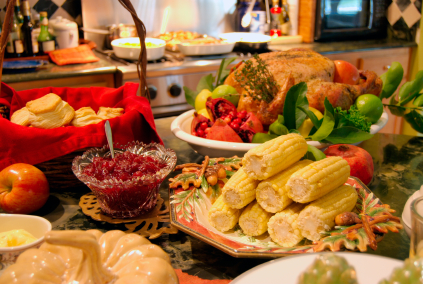Looking forward to Thanksgiving but not looking forward to all of the calories? No worries! There’s plenty of ways to avoid the calorie overload this Thanksgiving without missing out on great food and festivities.
1) Find a local Turkey Trot. Many towns and cities around the country host short runs called “Turkey Trots”. They usually benefit a charity and are very casual. If running is not your thing, you can walk it. It’s a great way to burn some extra calories before the big meal.
If you can’t find a Turkey Trot, make up your own. Encourage the family to join you for a walk, hike, or even a game of flag football.
2) Eat breakfast. Beware of the temptation to skip meals to “save room” for the big feast. This not only slows down your metabolism, it increases the likelihood that you will seriously overeat during Thanksgiving dinner.
3) Watch the appetizers! Stick to the veggie plate and eat fewer of the high calorie choices.
4) Eat normal portion sizes. Treat Thanksgiving like any other meal. Avoid eating until you feel stuffed. You can always go back for more later.
5) Make conscious swaps! Consider trade-offs. For example, if eggnog is your thing, then you may want to have only a few bites of pumpkin pie. Spend the calories on the foods you know you may feel like you missed out on.
6) Trim the calories on the sides dishes. If you are cooking, consider using lower calorie recipes for some of the traditional sides. Try websites like Cooking Light or Eating Well, or do an internet search for the “light” version of the recipes on your menu. If family and friends are bringing dishes — ask those you know would be on board to do the same.
This recipe can be made as an alternative to heavy, butter laden mashed potatoes. Your guests may not even realize they aren’t eating mashed potatoes!
Creamy Cauliflower Puree
courtesy of IDEA magazine
1 large head of cauliflower, cut into 1-to 2-inch florets (5-6 cups)
2-4 cloves garlic, peeled
2 cups vegetable broth or water (low sodium optional on the broth)
1 tsp. sea salt, plus more when pureeing
1/4 cup olive oil
1/4 tsp. freshly ground pepper
1 heaping tbs fresh herbs to garnish (chives or parsley would be good)
In large sauce pot or steamer, place cauliflower, garlic, broth or water, and sea salt. Cover and bring to a boil, then reduce heat and simmer 10-15 minutes or until tender. Stir occasionally to ensure even cooking. Drain, reserving cooking liquid.
Puree in two batches in food processor until smooth, scraping down sides as needed. With motor running, add 1/4 cup cooking liquid, half the olive oil, pepper, and a pinch of sea salt to each batch. Adjust seasoning to taste. Transfer to serving dish, top with herbs and serve hot. Can be made ahead and kept warm or reheated on low. Serves six.
Note: If you don’t have access to food processor, substitute handheld blender. Kick up puree flavor with 1-2 teaspoons or two Keen’s dry mustard powder, curry powder, or a little parmesan cheese.
It’s easy to have fun and keep the calories down on Thanksgiving with a small amount of planning. Have a tip or recipe you’d like to share? Please leave a comment below. It’s always great to hear from you!
Have a blessed Thanksgiving!
Jennifer



